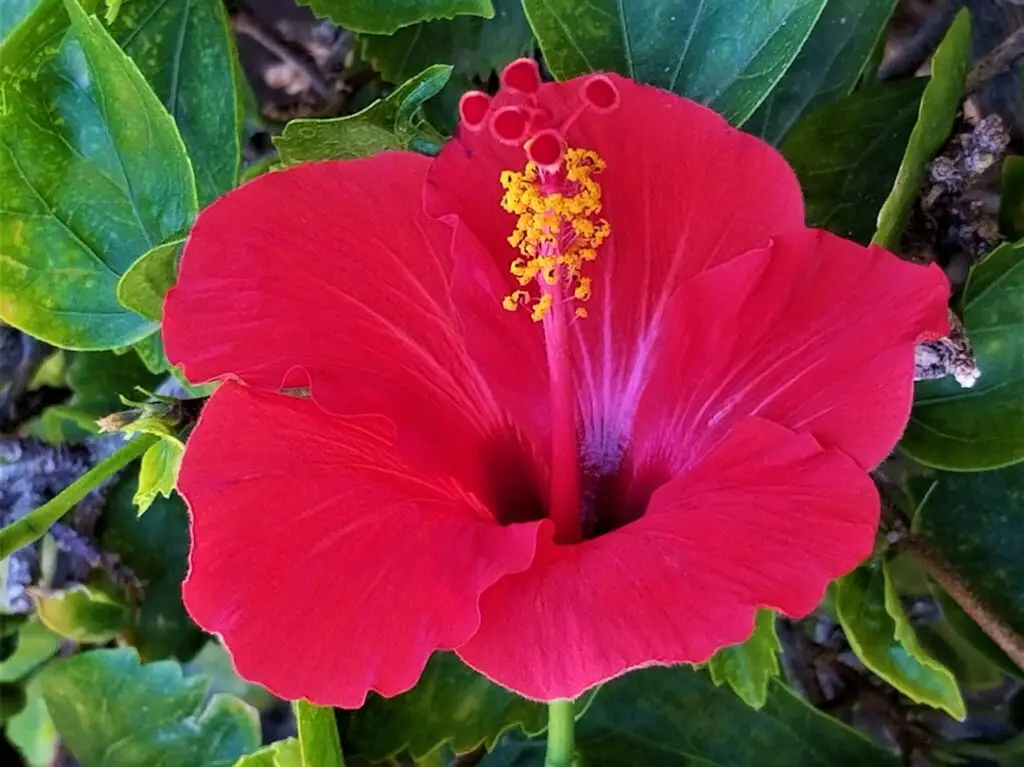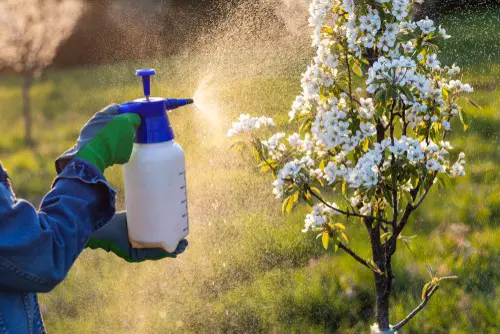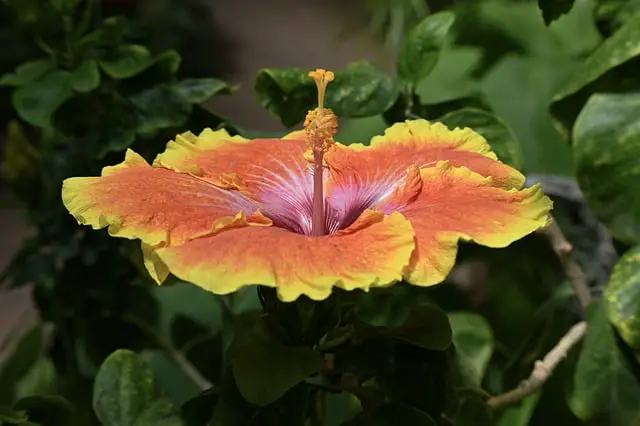Hibiscus plants are known for their bright and beautiful flowers, but they can also be susceptible to black spots on their leaves. These unsightly spots can be caused by a variety of factors, including pests, fungal infections, and poor growing conditions.
Understanding the causes of black spots on hibiscus leaves is essential for preventing and treating them. Pests such as aphids, scales, and whiteflies can deposit sticky waste on the leaves, leading to the development of black spots.
Fungal infections can also thrive in warm, humid conditions, causing yellow or black spots to appear on infected leaves. Overwatering, poor drainage, and lack of sunlight can also contribute to the development of black spots on hibiscus leaves.
By identifying the causes of black spots on hibiscus leaves, gardeners can take steps to prevent them from occurring in the first place.
Proper watering and drainage, regular pruning, and removing infected leaves can all help to keep hibiscus plants healthy and free from black spots. If black spots do appear, there are several treatment options available, including fungicides, insecticides, and natural remedies.
Key Takeaways
- Understanding the causes of black spots on hibiscus leaves is essential for preventing and treating them.
- Proper watering, pruning, and removing infected leaves can help to prevent black spots from occurring.
- Treatment options for black spots on hibiscus leaves include fungicides, insecticides, and natural remedies.
Also don’t miss:
Understanding Black Spots on Hibiscus Leaves

Hibiscus plants are popular for their vibrant flowers and lush foliage. However, black spots on hibiscus leaves can be a common problem that affects the plant’s overall health and appearance. In this section, we will explore the causes of black spots on hibiscus leaves and how to prevent and treat them.
Causes of Black Spots on Hibiscus Leaves
Black spots on hibiscus leaves can be caused by various factors, including fungal infections, bacterial leaf spot, and black spot fungus. These conditions are often triggered by environmental factors such as humidity, temperature, and moisture.
Fungal infections are a common cause of black spots on hibiscus leaves. The fungus can thrive in warm, humid conditions and can spread rapidly, causing extensive damage to the leaves.
Bacterial leaf spot is another common cause of black spots on hibiscus leaves. This condition is caused by bacteria that infect the plant through wounds or other openings on the leaves.
Black spot fungus is a fungal disease that affects many types of plants, including hibiscus. It appears as circular, black spots on the leaves and can cause the leaves to yellow and drop prematurely.
Sooty black mold is another condition that can cause black spots on hibiscus leaves. This fungus grows on the honeydew excreted by pests such as aphids and scales.
Prevention and Treatment of Black Spots on Hibiscus Leaves
Preventing black spots on hibiscus leaves involves maintaining proper growing conditions, including proper watering, pruning, and fertilization. It is also essential to keep the plants free from pests and to remove any diseased leaves promptly.
Treating black spots on hibiscus leaves can involve a combination of methods, depending on the cause of the problem. For fungal infections, fungicides can be effective in controlling the spread of the disease. For bacterial leaf spot, removing and destroying infected leaves can help prevent the spread of the disease.
Black Spots on Hibiscus Leaves
Hibiscus plants are popular for their beautiful flowers and lush green foliage. However, black spots on the leaves can be a sign of trouble. In this section, we will discuss the various causes of black spots on hibiscus leaves.
1. Fungal and Bacterial Diseases
One of the most common causes of black spots on hibiscus leaves is fungal and bacterial diseases. These diseases are caused by an overgrowth of fungi and bacteria, which can be triggered by environmental factors such as high humidity, poor air circulation, and overwatering.
Some of the common fungal and bacterial diseases that cause black spots on hibiscus leaves are:
- Gray mold
- Leaf spots
- Sooty mold
To prevent fungal and bacterial diseases, it is important to maintain good plant hygiene. This includes removing dead leaves and flowers, avoiding overhead watering, and ensuring proper air circulation around the plant.
2. Pest Infestation

Another common cause of black spots on hibiscus leaves is pest infestation. Pests such as aphids, spider mites, mealybugs, thrips, scale insects, and whiteflies can cause black spots on hibiscus leaves by depositing honeydew, a sticky waste product that these pests excrete.
The honeydew attracts fungi and bacteria, which can cause black spots on the leaves.
To prevent pest infestation, it is important to regularly inspect the plant for signs of infestation and take appropriate measures to control the pests. This may include using insecticidal soap, neem oil, or other organic or chemical pesticides.
3. Environmental Factors
Environmental factors such as weather and humidity can also contribute to the development of black spots on hibiscus leaves. Cool, damp weather can create ideal conditions for the growth of fungi and bacteria, while high humidity can promote the growth of pests.
To prevent black spots on hibiscus leaves due to environmental factors, it is important to provide the plant with proper care and maintenance. This includes providing adequate sunlight, avoiding overwatering, ensuring proper drainage, and maintaining good air circulation around the plant.
Identifying Black Spots
Black spots on hibiscus leaves can be an indication of a fungal or bacterial infection. It is important to identify the cause and take action quickly to prevent further damage to the plant.
Appearance
Black spots on hibiscus leaves can appear on the tops or undersides of foliage. These spots can be small or large and may be circular or irregular in shape. The spots may also be surrounded by a yellow halo. In some cases, the entire leaf may turn yellow and fall off the plant.
Progression
If left untreated, black spots on hibiscus leaves can spread to other parts of the plant, including the buds and flowers. The leaves may also become covered in a sooty mold, which can further damage the plant. It is important to take action as soon as possible to prevent the spread of the infection.
To identify the cause of the black spots, it is important to look for other symptoms such as yellowing leaves or discoloration. Pests such as aphids and mites can also cause yellowing of the leaves, which can be mistaken for a fungal or bacterial infection.
By identifying the cause of the black spots and taking appropriate action, it is possible to save the plant and prevent further damage.
Preventing Black Spots on Hibiscus Leaves

Hibiscus plants are well-loved among flowering garden plants for their size, color, and aesthetic appeal of blossoms. However, hibiscus plants are also prone to developing black spots on their leaves, which can be a sign of a fungal or bacterial infection. Here are some ways to prevent black spots on hibiscus leaves.
1. Proper Watering and Nutrition
Proper watering and nutrition are essential to maintaining healthy hibiscus plants. Watering hibiscus plants deeply and infrequently is recommended, as overwatering can lead to root rot and other fungal diseases.
It’s also important to avoid getting water on the leaves, as wet leaves can promote the growth of fungal spores.
Additionally, hibiscus plants require regular fertilization to maintain their health. Using a balanced fertilizer with a ratio of 10-10-10 or 20-20-20 can provide the necessary nutrients for healthy growth.
2. Maintaining Plant Health
Maintaining plant health is crucial to preventing black spots on hibiscus leaves. Regularly inspecting the plants for signs of pests, diseases, or stress can help identify problems early on.
Providing adequate air circulation around the plants can also help prevent the growth of fungal spores. Additionally, avoiding stressful conditions such as extreme temperatures, wind, or direct sunlight can help keep the plants healthy.
3. Effective Pruning
Effective pruning can help prevent the growth of black spots on hibiscus leaves. Pruning hibiscus plants regularly can help remove infected or damaged leaves and promote healthy growth.
It’s important to use clean, sharp pruning tools to avoid spreading any diseases. Additionally, removing any dead or diseased plant material from around the plants can help prevent the spread of fungal spores.
By following these tips for proper watering and nutrition, maintaining plant health, and effective pruning, gardeners can help prevent the growth of black spots on hibiscus leaves.
Treatment Options for Black Spots

If your hibiscus plant has black spots on its leaves, it is essential to take action to prevent the spread of the disease. There are several treatment options available to help control black spots on hibiscus leaves.
The two main categories of treatments are Natural Remedies and Chemical Treatments.
Natural Remedies
Natural remedies are an excellent option for those who prefer to avoid using chemical pesticides. Here are some natural remedies that can help control black spots on hibiscus leaves:
- Neem oil: Neem oil is a natural fungicide that can help control black spots on hibiscus leaves. It works by disrupting the life cycle of the fungus, preventing it from reproducing and spreading. To use neem oil, mix 2 tablespoons of neem oil with 1 gallon of water and spray the solution on the affected leaves.
- Insecticidal soap: Insecticidal soap is a natural pesticide that can help control black spots on hibiscus leaves. It works by suffocating the insects that are causing the damage. To use insecticidal soap, mix 2 tablespoons of soap with 1 gallon of water and spray the solution on the affected leaves.
- Horticultural oil: Horticultural oil is a natural pesticide that can help control black spots on hibiscus leaves. It works by suffocating the insects that are causing the damage. To use horticultural oil, mix 2 tablespoons of oil with 1 gallon of water and spray the solution on the affected leaves.
Chemical Treatments
Chemical treatments are an effective option for those who need a more aggressive approach to control black spots on hibiscus leaves. Here are some chemical treatments that can help control black spots on hibiscus leaves:
- Fungicides: Fungicides are chemical pesticides that can help control black spots on hibiscus leaves. They work by killing the fungus that is causing the damage. To use fungicides, follow the instructions on the label carefully.
- Bayer Advanced 3-in-1: Bayer Advanced 3-in-1 is a chemical pesticide that can help control black spots on hibiscus leaves. It works by killing insects, mites, and fungi that are causing the damage. To use Bayer Advanced 3-in-1, follow the instructions on the label carefully.
- Miticide: Miticides are chemical pesticides that can help control mites that are causing the damage. They work by killing the mites. To use miticides, follow the instructions on the label carefully.
- Anti-fungal: Anti-fungal treatments are chemical pesticides that can help control fungal diseases that are causing the damage. They work by killing the fungus. To use anti-fungal treatments, follow the instructions on the label carefully.
Recovery and Future Care

After addressing the issue of black spots on hibiscus leaves, it’s important to continue monitoring the plant’s health to ensure that the problem does not reoccur.
Here are some steps to take for continued care:
Monitoring Plant Health
Regularly check the hibiscus plant for any signs of stress or disease. This includes inspecting the leaves, flowers, and roots. If there are any new black spots on the leaves or petals, it may indicate a fungal disease such as botrytis blight or gray mold.
If the leaves are turning yellow or the foliage is showing signs of chlorosis, it may indicate a nutrient deficiency or soil pH imbalance. In such cases, a soil test may be helpful to determine the cause of the problem.
Continued Prevention
Prevention is key to ensuring the continued health of the hibiscus plant. Here are some tips to help prevent black spots on hibiscus leaves:
- Provide the hibiscus plant with warm temperatures and plenty of sunlight to promote healthy photosynthesis and sap flow.
- Avoid overwatering the plant, as this can lead to root rot and other fungal diseases.
- Regularly prune the hibiscus plant to encourage air circulation and prevent the growth of galls or other deformities.
- Attract beneficial insects such as ladybugs to the garden to help control pests that may spread disease.
- Use a fungicide or other treatment to prevent powdery mildew and other fungal diseases from infecting the hibiscus plant.
Frequently Asked Questions
How do you treat black spots on hibiscus leaves?
Black spots on hibiscus leaves can be treated by removing the affected leaves and disposing of them properly. It is also important to keep the plant well-watered and fertilized to promote healthy growth. Using a fungicide can also help to prevent the spread of the disease.
What are the little black dots on my hibiscus?
The little black dots on hibiscus leaves are likely caused by a pest infestation. Aphids, scales, and white flies are common pests that can cause dark spots on hibiscus foliage.
These pests deposit honeydew, which is a sticky waste that can lead to the formation of sooty mold on the leaves and stems.
How do you treat black spot on plants?
Black spot on plants can be treated by removing the affected leaves and disposing of them properly. It is important to keep the plant well-watered and fertilized to promote healthy growth. Using a fungicide can also help to prevent the spread of the disease.
What is the spot on my hibiscus leaves?
The spot on hibiscus leaves is likely caused by a fungal infection or pest infestation. It is important to identify the cause of the spot and take appropriate measures to treat it. Removing the affected leaves and using a fungicide can help to prevent the spread of the disease.
Best fungicide for hibiscus
The best fungicide for hibiscus depends on the specific type of fungus that is affecting the plant. Some common fungicides that are effective against fungal diseases on hibiscus include copper-based fungicides, neem oil, and sulfur-based fungicides.
It is important to follow the instructions on the fungicide label carefully to ensure proper application and safety.
Yellow and brown spots on hibiscus leaves
Yellow and brown spots on hibiscus leaves can be caused by a variety of factors, including fungal infections, pest infestations, and nutrient deficiencies.
It is important to identify the cause of the spots and take appropriate measures to treat the underlying issue. Removing the affected leaves and using a fungicide or insecticide can help to prevent the spread of the disease. Proper fertilization can also help to address nutrient deficiencies.

Hey, I’m Lisa and I’ve been an avid gardener for over 30 years. I love writing, talking and living in the garden! Feel free to connect with me on my socials below

